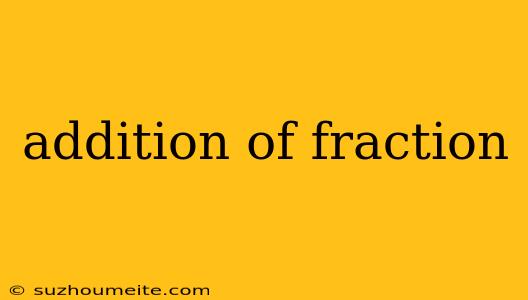Addition of Fractions
Adding fractions can seem tricky at first, but with a few simple steps, it becomes straightforward. Here's a breakdown of how to add fractions:
Understanding Fractions
A fraction represents a part of a whole. It has two main parts:
- Numerator: The top number represents the number of parts you have.
- Denominator: The bottom number represents the total number of equal parts the whole is divided into.
Adding Fractions with the Same Denominator
When the fractions have the same denominator, the process is easy:
- Add the numerators.
- Keep the denominator the same.
Example:
1/4 + 2/4 = (1 + 2)/4 = 3/4
Adding Fractions with Different Denominators
When fractions have different denominators, we need to find a common denominator:
- Find the Least Common Multiple (LCM) of the denominators. The LCM is the smallest number that both denominators divide into evenly.
- Convert each fraction to an equivalent fraction with the LCM as the denominator. To do this, multiply both the numerator and denominator of each fraction by the factor that makes the denominator equal to the LCM.
- Add the numerators.
- Keep the common denominator.
Example:
1/2 + 2/3
- LCM of 2 and 3 is 6.
- Convert:
- 1/2 = (1 * 3)/(2 * 3) = 3/6
- 2/3 = (2 * 2)/(3 * 2) = 4/6
- Add: 3/6 + 4/6 = (3 + 4)/6 = 7/6
- Simplify (if possible): 7/6 can be written as 1 1/6
Simplifying Fractions
After adding, it's often necessary to simplify the resulting fraction to its lowest terms:
- Find the greatest common factor (GCF) of the numerator and denominator. The GCF is the largest number that divides both numbers evenly.
- Divide both the numerator and denominator by the GCF.
Example:
4/8 simplified to its lowest terms is 1/2 (dividing both by 4).
Mixed Numbers
When adding mixed numbers (a whole number and a fraction):
- Add the whole numbers.
- Add the fractions.
- If the fraction is improper (numerator is larger than the denominator), simplify it to a mixed number and add it to the whole number part.
Example:
2 1/4 + 1 2/3
- Add whole numbers: 2 + 1 = 3
- Add fractions: 1/4 + 2/3 = (3/12) + (8/12) = 11/12
- Combine: 3 + 11/12 = 3 11/12
Real-World Applications
Adding fractions is essential in many everyday situations:
- Cooking and Baking: Following recipes often involves combining ingredients in fractional amounts.
- Measurement: Measuring lengths, distances, or volumes can often involve fractions.
- Sharing: Dividing things fairly often requires understanding fractions.
By mastering the steps and understanding the concepts, you can confidently add fractions in any situation.
